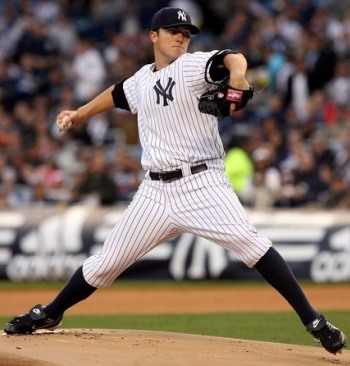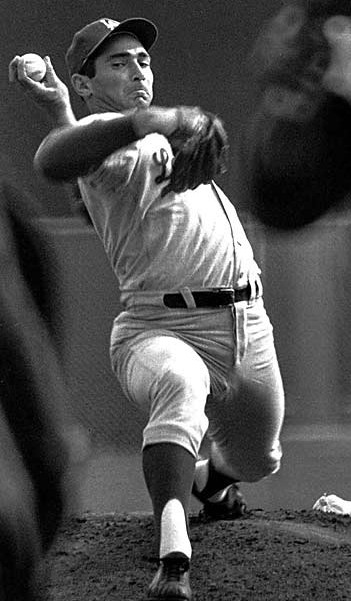While the pause in official games for the mid-summer classic is not exactly the half-way point of the season (most teams have played 86-88 games) it's a convenient place to stop and take a look around, seeing what's happened up to now. More important, it's also a good time to try to figure out what the first half means for the second half of the season, if anything at all.
Last year, the Phillies, Dodgers, Cubs and Brewers made it to the postseason, and three of those four teams are in the thick of the pennant race once again. before the season, if you'd asked me which of the four would not be in the mix, I'd have guessed that Milwaukee, having lost CC Sabathia to the Yankees, would have slipped. The Brewers have slipped of course, but not as much as I expected.
Meanwhile, the Cubs have completely fallen apart. They went from winning 97 games last year to a mediocre 43-43 at the Break, and the reasons are obvious. The pitching is almost exactly as good this year as last, but the hitting has fallen off a cliff. Last year the Cubs led the National League with 855 runs scored, whil they rank second to last in runs this year. Carlos Zambrano, a pitcher who's had only 41 plate appearances, has more homers (3) than the entire team's second base corps (2), in 344 plate appearances.
In their place, the St. Louis Cardinals sit atop the NL Central, with a 2.5 game lead over the Brewers. They won 86 games last year, and though their offense has slipped a bit, the pitching has more than made up for it. Chris Carpenter, four years removed from his Cy Young season and two years from Tommy John surgery, is both healthy and effective, but Joel Piniero has to be the real surprise.
After both the Mariners and Red Sox gave up on him, the Cardinals gave him a chance in 2007, and the results have been mixed. Last year's performance, a 5.15 ERA in 148 innings, did not seem to suggest that he'd found whatever had made him a winner in Seattle once upon a time. but this year he leads the National League in the fewest walks and fewest homers per nine innings, as well as complete games (3) and shutouts(2).
Oh, and losses (9), but this is because he gets the 6th worst run support in the major leagues (among pitchers with at least 80 innings). Albert Pujols is having perhaps the best season of his already amazing career, and he's practically carrying the offense. Ryan Ludwick, whicle still solid, has dropped off considerably from last year's performance. Rick Ankiel is hitting just .215 and has lost his job to rookie Colby Rasmus, who has held his own.
Troy Glaus, who drove in 99 runs last year, is injured and his replacements have been horrendous, combining to hit .214 with six homers. Cardinals' left fielders, mostly Chris Duncan, have been just as bad, but at least Glaus is expected back at the end of July. The team's last effort to improve at these positions, Mark Derosa, got hurt in the middle of his third game with the team and is done for the year.
The team may look to upgrade again, but more likely they'll just wait for Glaus to return and try to hold onto their lead. The soft NL Central division seems winnable for this team, especially if Piniero keeps pitching like he has been. Nobody else appears poised to make a run at the Cardinals, though with five teams within five games of the division lead, anything could happen.
Another surprise this year has been the San Francisco Giants' ability to contend. Currently they, not the Cubs, Brewers, or Mets, lead the NL Wild Card race, with a 49-39 record. They're not likely to catch the Dodgers, who have the best record in MLB, but their pitching (both the starters and the relief corps) is the best in the league and has helped them to compensate for an offense that ranks near the bottom of the Senior Circuit.
Defending NL Cy Young Award winner Tim Lincecum leads the staff with 10 wins, 149 K's and a 2.33 ERA, but Matt Cain is 10-2 as well, with a 2.38 ERA. Randy Johnson and Barry Zito are not what they once were, but each is capable of pitching a decent game on occasion. The Big Unit is 5-2 with a 3.18 ERA in his last nine starts and perhaps is poised for a big second half, now that all the hoopla surrounding his 300th career Win is in the past.
Jonathan Sanchez just pitched a no-hitter, hinting perhaps that the lanky lefty may be turning a corner of sorts. His minor league numbers (333 strikeouts and only 12 homers allowed in 253 innings) suggest that he can be very good.
In the non-surprise category, Barry Zito, has been maddeningly inconsistent, pitching eight shutout inning in one game and following that up by allowing nine runs in four-plus innings in his very next outing. And this kind of thing has been going on all year. He was so bad in his first two starts in April that he got himself banished to the bullpen, though he never actually pitched in relief. He came back from that and pitched seven shutout innings to start off a 9-game stretch in which he posted a 2.91 ERA. But in the last month he's posted an ERA of 7.04 in 38 innings over seven starts.
Never mind all the money he's making. If the Giants are going to make it to the playoffs, they need to know which Barry Zito is going to show up for the second half of the season, and so far nobody's been able to figure that out.
The offense, such as it is, ranks just 4th from the bottom of th NL, tied with Houston at 4.18 Runs per game, though given that the Giants play in a pitcher-friendly park and the Astros play in a bandbox, they're probably a little better than they seem at first glance. Second base has been a black hole for the team, hitting just .238/.294/.314, though Juan Uribe is bringing those numbers up. Shortstop and left field haven't been much better, and as much as I like his name, Travis Ishikawa is a firstbaseman who hits like a shortstop.
The only players who have been above average for their positions are Aaron Rowand and Pablo Sandoval. the Giants bought high with Rowand, signing him to a big multi-year contract right after he hit 27 homers for the Phillies, and they've never really seen that form, though his .288/.348/.458 line is respectable enough for a center fielder. Of course, you expect to get more than "respectably" when you shell out ten million dollars for a player, but that's beside the point. Rowand is not the problem.
And neither is Sandoval. Kung Fu Panda (aptly nicknamed for his *ahem* physique and for some in-game acrobatics last season) is hitting .333, a notch better than Albert Pujols, and with 15 homers to boot. last year he hit.350/.394/.578 combined at High A and AA and then hit .345 in a late-season cup of coffee with San Francisco.
He absolutely raked in spring training and basically hasn't stopped. His OPS is 7th in the NL right now, better than Lance Berkman, Adam Dunn, Carlos Beltran, Chipper Jones and dozens of other household names making 20 times what Pandoval earns. He's the feel-good story of the Bay Area, and he was passed over for the All Star game so that Charlie Manuel could take his favorite toy to the game with him. Ryan Howard, with his .257 batting average, will be one of five Phillies on the roster.
But that's one game. The Giants get Pandoval and his bat for the rest of the year, and if he can get some help, any help at all, the Giants will win the NL Wild Card easily. But if the pitching slips at all, and you would think it will have to slip a little, the Giants will have a tough time holding that lead.
On the bottom end of the National League standings are most of the usual suspects: the Pirates, Padres, and especially the Washington Nationals. This isn't exactly a surprise, at least not that they would be a poor team, but some people saw the acquisitions of Adam Dunn, Josh Willingham and Scott Olsen, adding them to a core that included Nick Johnson, Ryan Zimmerman, and two high-upside talents like Lastings Millege and Elijah Dukes, and thought the Nationals might not be so terrible this year.
Some of those hitters have hit, but Dukes has not and Millege wore out his welcome and found himself sent off to Pittsburgh. And the terrible pitching and defense (they lead the majors in errors) have more than compensated for any quality the batters may display.
The Nats' bats have been decent enough, ranking 8th in the NL in runs per game, but the pitching has been atrocious. Washington has allowed an average of 5.62 runs per game, with an adjusted ERA 17% worse than the NL average. Only San Diego, who allows over five runs per game despite playing half their games in the best pitchers' park in the majors, is worse, at 20% below average.
The Nationals have improved just a bit in the last few months, improving from "historically bad" to "god-awful" and are currently on a pace to lose 114 games. Their runs scored/against ratio suggests a 34-win team rather thana 26-win team, so they may improve over the second half, but they could do that and still lose 100+ games. I hope they can afford another #1 draft pick next year after breaking the bank for Stephen Strasburg.
They just fired their manager, Manny Acta, and replaced him with Jim Riggleman, who's an experienced manager if not a good one. Acta's .385 career winning percentage in the majors is the 10th worst all-time amongst the 291 of them with at least two full seasons worth of games under their belts. Interestingly, two of the nine guys with worse records than Acta also managed teams in Washington. Joe Cantillon went 158-297 from 1907-09 for the old Washington Senators and never managed again in the majors. Then starting in 1961 Mickey Vernon went 135-227 and was mercifully fired a third of the way into the 1963 season for the new Washington Senators. Of the bottom 25 managers on that list, only Vernon got a shorter leash than Acta, 363 games compared to 410.
Both of those Senators teams eventually left town for greener pastures (or in the case of the ones who went to Minnesota, greener carpet) and you have to wonder how long they can keep this kind of ineptitude going before these Washingtons have to leave town, too.


















